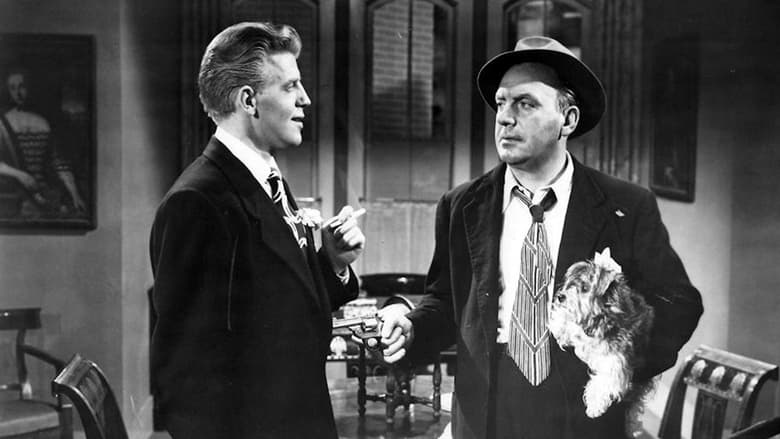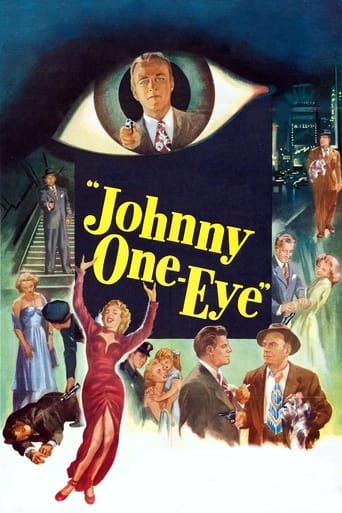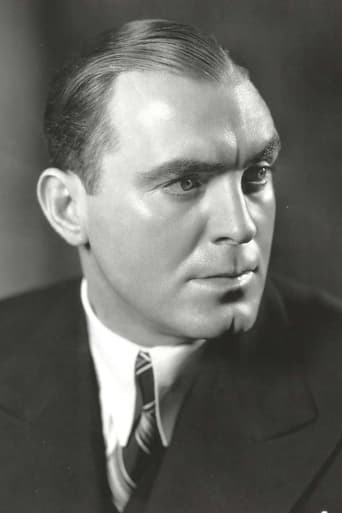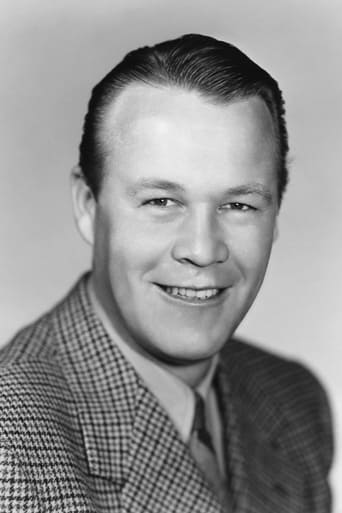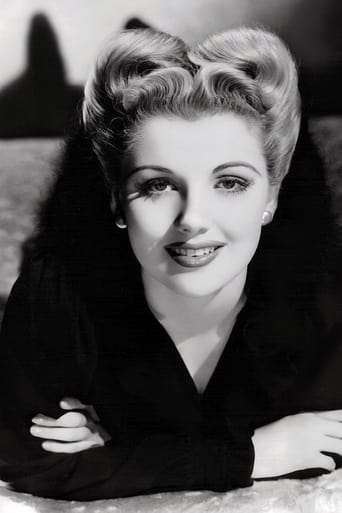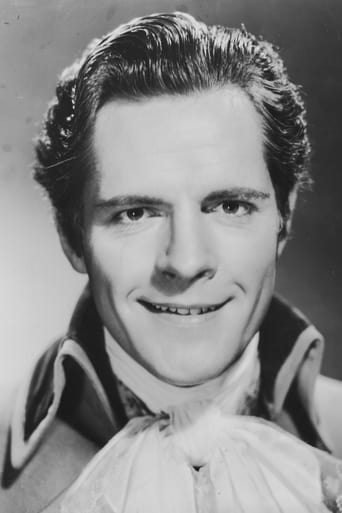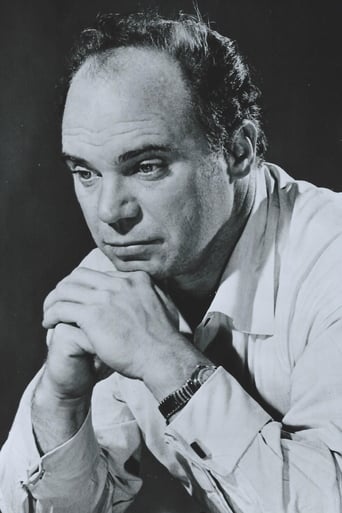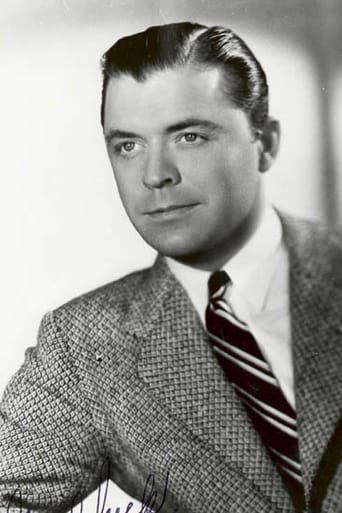Johnny One-Eye was adapted from one of Damon Runyon's lesser-known stories. Martin Martin and Dane Cory were former partners in crime who have long since split up. When a new district attorney puts the heat on, Cory, anxious to save his own hide, accuses Martin of an unsolved murder. Holed up in abandoned house, Martin is befriended by a little girl and her dog. It so happens that the girl is the daughter of the crusading DA, and thereby hangs the rest of this tale.
Reviews
Fanciful, disturbing, and wildly original, it announces the arrival of a fresh, bold voice in American cinema.
This is one of the best movies I’ve seen in a very long time. You have to go and see this on the big screen.
There are moments in this movie where the great movie it could've been peek out... They're fleeting, here, but they're worth savoring, and they happen often enough to make it worth your while.
The film's masterful storytelling did its job. The message was clear. No need to overdo.
In New York City, rich and respectable Park Avenue ex-gangster Pat O'Brien (as Martin Martin) finds out guttery ex-partner Wayne Morris (as Dane Cory) is planning to go straight to the D.A. and squeal about the events surrounding the film's opening. As this would put Mr. O'Brien behind bars and get Mr. Morris off easily, the two men have a nasty confrontation. O'Brien takes a bullet in the shoulder, and goes on the lam. A "WANTED" man, O'Brien makes his way into the Greenwich Village neighborhood where Morris keeps an apartment for busty blonde Dolores Moran (as Lily White)...Ms. Moran lives with her illiterate - but smartly talkative - daughter Gayle Reed (as Elsie) and their dog "Skipper". Morris likes to make time with Ms. Moran, but loathes little girl cuteness and furry animals; he wants the kid sent to school, then kicks and wounds "Skipper". The disabled canine meets O'Brien, who names him "Johnny One-Eye". Next, O'Brien meets little Miss Reed. O'Brien tells the gullible girl he's really "Santa Claus". This was based on a story by Damon Runyon, but hacks out his whimsy. Highlights include authentic New York locations and a velvety-voiced supporting cast.**** Johnny One-Eye (5/5/50) Robert Florey ~ Pat O'Brien, Wayne Morris, Dolores Moran, Gayle Reed
***SPOILERS*** Based on an obscure Damon Runyon short-story the movie "Johnny One-Eye" is about an on the lamb wanted killer who was turned in to the D.A by his partner in order to save his own neck by coping a plea in a murder rap.We get to see Dutch gunned down on the Statan Island Ferry by Martin Martin, Pat O'Brien, who pulled a gun on him after dropping $50,000.00 in cash that he ripped off from both Martin and his partner Dane Cory, Wayne Morris. It's now some five years later and Martin now a successful businessman is told by this arrogant sleaze-ball Ambose, Lawrence Cregar, who got a spy in the D.A's office that Cory is making a deal in fingering Martin in the Dutch murder.Martin like a complete fool goes to see Cory, whom he knows is untrustworthy, who's now in the theater business and ends up getting shot by one of his men Cute Freddy, Harry Bronson,who ends up getting killed by Martin in the crossfire. Badly injured Martin despite having his picture on every newspapers as well as on the TV news walks from the midtown Theater District to Greenwich Village, about two miles, without anyone, man woman or cop, recognizing him as well as offering the badly injured Martin any medical attention.Hiding in this abandoned building Martin is discovered by Elsie, Gayle Reed, and her cute but badly inured dog, the poor mutt is blinded in one eye, Skippy. It just happens that Elsie's mother Lily White, Dolores Moran, is one of Cory's discoveries in the theater whom he promised to make a star. Befriending Elsie and her mutt Skippy Martin calls him Johnny One-Eye and tells the very young, she's about four years old, and impressionable Elsie that he's actually Santa Clause in disguise, Martin doesn't have a white beard and a Santa Clause outfit, from a wanted photo of himself that Elsie shows him in a local newspaper.The movie has Martin later find out about Cory's involvement with Elsie's mom as well as his mistreatment of both Lily Elsie as well as Johnny-One-Eye, or Skippy, whom the despicable hoodlum blinded by kicking the pooch in the face. Martin in trying to get Johnny One-Eye help or find him a home goes to this Greenwich Village veterinarian, Donald Woods, who tells him that the best thing he could do for very sick Johnny One-Eye is put the dog to sleep. It's later when Woods repairs Martin's chest wound that he goes to see Ambrose about having a meeting with Cory offering him $15,000.00 in finding out Cory's whereabouts so that he can pay him a visit and pay him back for what he did to him.True to form Ambrose double-crosses Martin by setting him up to be turned over to Cory, for $25,000.00. It's then that Ambrose's henchman a member of the D.A's staff and possibly Ambrose gay lover Francis, Lyle Talbot,gets cold feet in being afraid of losing his job, he was told by the lying Ambrose that Martin was to be turned over to the police. Where there's another shoot-out with both Francis getting cold cocked by Martin and Ambose ending up shot dead by an outraged Francis.Finding out that Cory is living across the street from where he's hiding out in the abandoned building, what a small world, Martin has him alerted by Elsie where he is that leads to the final shoot-out with both himself and Cory ending up dead. With what little life he still has left to him as he's dying from a bullet wound Martin tells one of the cops, who later came on the scene, to buy Elsie a new dog, Johnny One-Eye didn't have long to go by then, and make her think that the dog is her beloved pet Skippy or as Martin called him Johnny One-Eye.
Despite the film's original storyline, director Robert Florey, who was well past his prime when this low-budget programmer was made, does injustice to a very original Damon Runyon's plot idea. An innocent but plucky young girl naively believes that a criminal fugitive (Pat O'Brien) who's hiding out in a deserted building in her neighborhood, is really Santa Claus. She keeps his presence secret and does her best to help him. Florey fills the story with bathos and saccharine sentimentality involving the title character, the girl's little dog, and the film ultimately becomes mired in its own mawkishness.More than a decade later Bryan Forbes would direct a critically-acclaimed film based on a similar premise. In 1961's WHISTLE DOWN THE WIND, youngster Hayley Mills mistakenly believes fugitive wife-murderer Alan Bates, who is hiding out from the authorities in the barn on her father's isolated British farm, to be Jesus Christ. The tact and taste with which Forbes handles the material is a paradigm of understatement and restraint. Although Mary Hayley Bell's (mother of Hayley} narrative was lauded at the time for its great originality, the plot premise appears cribbed from this unpretentious Damon Runyon B-film programmer.
The title character is a mutt, and the story comes from the flamboyant pen of Damon Runyon. That's hardly the recipe for a moody, offbeat crime story, but Robert Florey, perhaps drawing on his French roots, adds that little je ne sais quoi and comes up with a casserole a cut above the ordinary. It's not quite a success but an honorable and occasionally arresting try.Runyon is best remembered for his sentimental yarns about Broadway, that garish gulch that disrupts Manhattan's tidy grid - stories of gold-diggers and raffish sportsmen, of old silver-tongued sots and big bruisers with 24-karat hearts. But he told more downbeat tales as well, as evidenced by Johnny One-Eye, where Florey more skillfully modulates the movie's dark tonality than did Irving Reis in The Big Street, with Lucille Ball and Henry Fonda, another of Runyon's more shadowed stories (perhaps Reis was overruled by Runyon, who acted as producer).Save for Pat O'Brien, Florey's smallish cast is nowhere near the caliber of The Big Street's (its next most recognizable member is Wayne Morris). Partners in petty crime years ago, O'Brien and Morris whacked a double-crosser and tossed his body off the Staten Island ferry. Since then they've drifted apart and gone legit, with O'Brien now occupying a pinnacle not only on Park Avenue but in the city's power structure as well. We get only a brief glimpse of his affluence and influence, however, in a scene where he brings hookers to his penthouse to pair off with politicos. An epicene blackmailer (Lawrence Cregar) working for Morris cuts short the festivities by calling down a police raid. O'Brien flees out into the city's meaner streets with only one mission - to find Morris and exact his revenge. He catches a bullet along the way, and holes up in a condemned brownstone in the Village, where he meets up with the poor mutt, Johnny One-Eye.Here the plotting plummets into the, well, Runyonesque. The dog belongs to the little girl of Morris' mistress (Dolores Moran), thus becoming the canine link which fatally reunites the old partners. Enough said, except to note that the tot (Gayle Reed) will harden the warmest of hearts, suggesting the least endearing attributes of Shirley Temple as Little Miss Marker, another of Runyon's creations.Florey can't quite toss out all the aggressively poignant slop - if he had, there would have little left to work with - but he accentuates the noirish elements (he had just directed John Payne in The Crooked Way, one of his more solid credits). During O'Brien's wounded, nocturnal flight, the skyscrapers loom like jagged black precipices. And the scenes in the abandoned town house, where he's visited by the little girl, bring to mind, in their sense of menacing isolation in the middle of a teeming city, Ted Tetzlaff's The Window, a hit of the previous year. (There's also a freighted scene with a boozing veterinarian that looks forward to a similar one in Andre De Toth's Crime Wave four years later.) Sad that Florey was relegated to nothing better than the Bs (even to the Bs among the Bs); given better material and looser budgets, his distinctive touch might have grown into a major talent.
Top Streaming Movies











